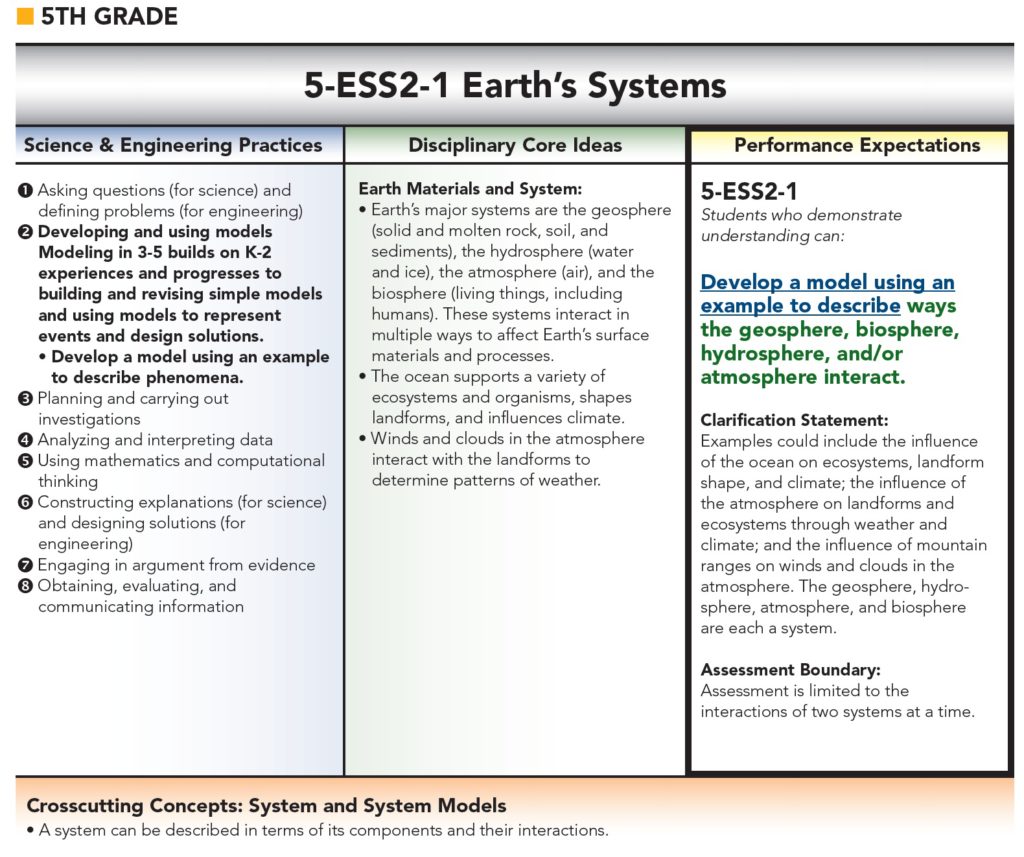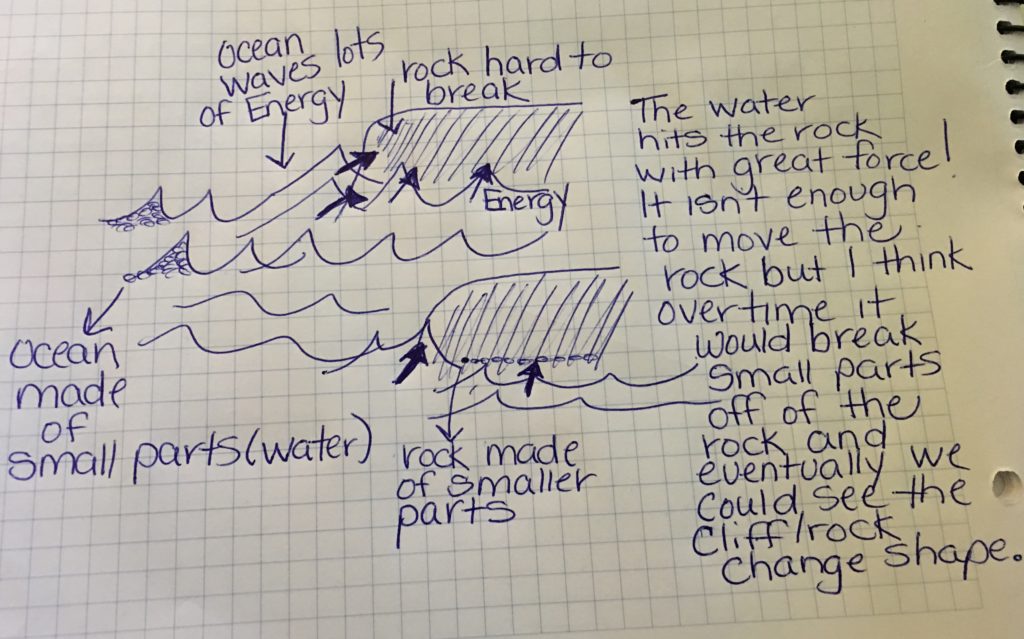18
2017
Generating Phenomena Ideas
Have you been looking at the new Oklahoma Academic Standards for Science and wondering how all of the information provided in each document helps you think about instruction to meet the goals of the standards? Recently, several 5th grade teachers were involved in a Facebook discussion about this very topic.
In an attempt to provide some guidance on how to utilize the information provided in the standards document, I’ve written a narrative of the steps I took to think through how to develop instruction aimed at 5-ESS2-1.
Remember, the guidance reflects the steps I would take as a teacher, but does not serve as a directive for instruction on this standard. I hope the steps help others as they unpack the standards themselves.
Step 1:
I’m going to start by looking at the Performance Expectation/Standard. For this example, let’s look at 5-ESS2-1 Develop a model using an example to describe ways the geosphere, biosphere, hydrosphere, and/or atmosphere interact.
From the onset, I begin to see a couple of things that are different from the way I previously taught about Earth’s major systems. It won’t be enough that students can recognize that the geosphere is made of things like rock, soil and sediment or that the hydrosphere includes water and ice. Students are going to need to be able to use a model that they create to describe how each Earth system might interact with another Earth system.
Step 2:
If I look at the clarification statement, I can see a few examples of Earth Systems interacting. The first example suggests that I can engage students in figuring out how the ocean (hydrosphere) interacts or influences the ecosystem (biosphere – plants and animals) or I could have students figure out how the ocean (hydrosphere) influences landform shape (geosphere). I could also have students examine how the ocean influences climate (atmosphere).
Other examples are given in the clarification statement. However, the assessment boundary lets me know that the assessment at this grade should be limited to students studying the interactions of two systems at a time. So even though the ocean interacts or influences several systems I am beginning to think I will only have students studying how the ocean interacts or influences one other system at a time.
With the examples provided and knowing that students are going to be expected to show their understanding of how Earth Systems interact, I’m starting to have a few ideas. I’m most intrigued with how the ocean (hydrosphere) influences landforms (geosphere). Specifically, I’m thinking about ocean tides moving sand as they come in and out.That is something students can observe on a video and draw a sketch to show how the two systems are interacting.
I’m also visualizing big ocean waves crash into the sides of cliffs in Ireland, so I google a video to observe for myself what this looks like since I’ve never been to Ireland! As I watch the video I begin to sketch out my observations and what I’m thinking about how the ocean waves interact with the rocks.
Please don’t judge, but I’m providing my sketch for you to see!
As I sketch out the ocean waves interacting with the cliffs of Ireland, I start to think about how those waves get to be that big and I realize that I know the wind has something to do with it! I’m now thinking about how I could add, yet another Earth System, atmosphere (air), to my sketch model drawing above.
STEP 3:
As I continue down this path of exploring and thinking about the examples provided in the clarification statement, I also look at the bulleted list under the middle green column of the standards document, Disciplinary Core Ideas (DCI). The Disciplinary Core Ideas comprise the science concepts or ideas that support students in being able to demonstrate their understanding of the Performance Expectation. The Performance Expectation is the end goal of instruction, which may take a few activities or lessons to fully achieve.
As I examine the DCI concepts I recognize a need for students to understand what things make up the individual Earth Systems and I think I can help students gain those understandings as they explore how the Earth Systems interact. For example, if students are describing how the ocean interacts with sand on the beach or rocks in Ireland, I can introduce them to the idea that the ocean is part of the hydrosphere and the sand and rock are part of the geosphere after they’ve had a chance to explore how they interact and they’ve had a chance to describe this interaction through their model.
Another thing I notice as I read the DCI concepts is that students should understand how, “Winds and clouds in the atmosphere interact with the landforms to determine patterns of weather”. I realize this will take another investigation. But first, I’m going to have to go find out a bit more about this myself. I think I have a good idea about how wind (atmosphere) interacts with landforms (mountains). If I stand on one side of a mountain I can feel no wind, but if I move to another side I feel a lot of wind! So I think the mountain blocks the wind, depending on the direction the wind is blowing.
However, I’m not sure how clouds interact with landforms to determine weather patterns. This is what I found after a bit of Internet researching.
There are two sides to a mountain: wayward and leeward. Whenever it is raining, the wayward side gets the rain. As a cloud goes up the mountain, it keeps raining until there is no more water in the cloud. Now, as the cloud starts to go down the other side of the mountain, there is no more precipitation. So, the leeward side of the mountain doesn’t get any rain. The flat ground on this side of the mountain is dry and humid.
With this information, I’m beginning to think of ways that I can have students examine rain levels on two sides of a mountain, over a span of time, so that they can see there is a pattern which should cause them to wonder why! I can capitalize on that wonder and engage students in gathering information through investigations and or reading materials to explain why this phenomenon occurs.
STEP 4:
Now that I have a better sense of the information provided to me in the standards document I’m thinking about all of the ways I can engage students in figuring out and explaining all of the natural phenomenon I’ve explored myself to this point. I’ve highlighted the natural phenomenon throughout this document in red for you to go back and see.
- Waves move sand on a beach: Hydrosphere and Geosphere
- Waves crash into cliffs in Ireland and will change the shape of the cliffs over time: Hydrosphere and Geosphere.
- Mountains block wind: Geosphere and Atmosphere.
- One side of a mountain gets lots of rain, while the other side doesn’t: Geosphere and Hydrosphere.
Here are additional natural phenomenon I’m thinking about that involve Earth Systems interacting.
- One side of a mountain has lots of plants, while the other side doesn’t: Hydrosphere and Biosphere.
- A river changes its path over time: Hydrosphere and Geosphere
- Wind moves pollen from one plant to another: Atmosphere and Biosphere
- Heavy rains cause puddles: Hydrosphere and Geosphere
- When soil is lacking plants it moves easier with wind and/or water: Biosphere and Atmosphere or Biosphere and Hydrosphere
The last phenomenon listed reminds me of the Dust Bowl and I realize that event in history occurred because of how Earth Systems were interacting!
STEP 5:
Now it’s time to decide which of the phenomenon I’m actually going to use and what supplies I might need to have students gather observational information about these phenomena. What I really want students to have as outcomes for each of the phenomena we explore are:
That they can describe how each Earth System is interacting with another Earth System in a model drawing.
That they know which Earth Systems are represented in each phenomenon and can describe the parts of each Earth system in a model drawing.
Resources Used to Unpack 5-ESS2-1:
OAS-Science Standards: pg 80
A Framework for K-12 Science Education: Earth’s Materials and System’s Section
NGSS Evidence Statement for 5-ESS2-1Resources Used to Unpack 5-ESS2-1: OAS-Science Standards: pg 80 A Framework for K-12 Science Education: Earth’s Materials and System’s Section NGSS Evidence Statement for 5-ESS2-1

 An article by
An article by 






